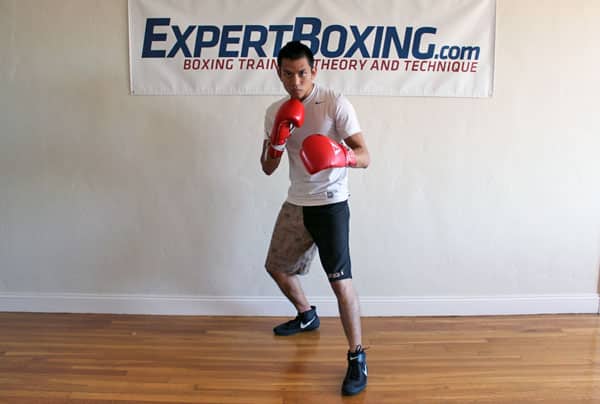
The average fighter has terrible footwork. And I’m not talking about the guy in the corner that’s only been boxing for 2 months, I’m talking about the AVERAGE AMATEUR-LEVEL COMPETING BOXER. Unfortunately, this might mean you.
And it’s NOT your fault. It’s not because you didn’t train hard enough. It’s simply a lack of understanding basic human anatomy. I’d love to write guides on fancy footwork one day, but right now 99% of you don’t even know these:
10 HUGE fighting footwork tips!
Watch my video for better demonstrations of boxing footwork technique.
1. Wear Boxing Shoes

C’mon now, guys. This is boxing! You shouldn’t be complaining about having bad footwork in the ring if you’re wearing tennis shoes in there. It’s like wearing a sweater into the swimming pool and complaining that you can’t move your arms. Really…it’s the same thing.
Boxing shoes are thinner allowing for more power transfer.
If you’ve ever put on a pair of boxing shoes, you’ll be amazed at how they feel more like a sock than a shoe. (A very durable sock, if you will.) Assuming you got a quality brand and not a $25 pair of boxing shoes, you’ll feel like a ninja in the ring. The thin soles allow your feet to feel and grip the ground like a panther pushing, pulling, and changing directions all over the canvas.
The problem with NON-boxing shoes, even other athletic shoes, is that their sole is too thick. This is because they’re built for shock absorption which means they DECREASE the amount of power transferred from the ground. The sole is so thick sometimes even so curved, that you can’t plant your feet firmly into the ground.
Even without a single footwork drill, you will feel much more slick and agile in the ring simply by buying a pair of shoes. This is boxing, so please get the proper gear. Having the right equipment is the bare minimum for achieving higher performance.
Your boxing footwork will be instantly better,
simply by wearing boxing shoes.
Boxing shoes prevent sliding BUT allow pivoting.
That’s the beauty of boxing shoes. They don’t let your feet slide BUT THEY DO let your feet pivot easily. You need the non-sliding feature to keep your body anchored to the ground, and then you need to be able to pivot so you can throw deadly punches with full body rotation.
The problem with NON-boxing shoes is that they either have too much grip or too little grip. If they have TOO LITTLE GRIP, you slide all over the place and can’t ground yourself. If they have TOO MUCH GRIP, you won’t slide but now you can’t pivot either without decreasing weight on the pivoting foot (which affects your punching power and ability to change directions).
Boxing shoes can exert more force to the ground WITHOUT SLIPPING,
resulting in better balance, footwork, and punching power!
Want to buy the same boxing shoes as me?
I use the Nike Lo Pro Boxing shoe. Some of you may prefer the hi-top version for more ankle support. I like the low ankle for more agility and also because I feel I already have strong ankles. I prefer Nike because of better comfort and feels. If I had to use any other brand, it would only be Adidas and probably nothing else.
2. Jump Rope More
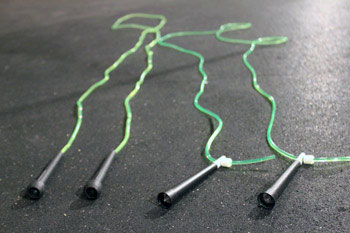
For those of you that don’t even jump rope in the first place, this would be a good time to start. Jumping rope is one of the greatest exercises for boxing. It improves your balance, footwork, punching power (YES, THIS), muscle endurance, breathing efficiency, muscle conditioning, and several more things. Basically, it’s a GREAT EXERCISE FOR BOXING! It’s like an all-in-one exercise that works out several things simultaneously and is pretty fun once you learn some tricks.
Jumping rope improves your leg conditioning.
If I had to choose an exercise that best mimics leg use in boxing, it’s the jump rope. The reason is because your legs are always contracting in tiny bursts–not only when you bounce in the ring but also when you punch. Jumping rope builds that leg muscle so you can have that powerful leg burst throughout an entire fight. Doing squats will never be as good because squats aren’t done fast enough and never get to hundreds of repetitions. The jump rope is fast and constant which is very similar to how you would use your legs during a fight.
Most importantly, the jump rope teaches you how to use your legs EFFICIENTLY. Many fighters don’t do the jump rope because it’s too tiring. Well if you keep it up, you will learn how to relax (using technique and breathing) so you can do hundreds of jumps without getting tired. This ability will allow you to throw hundreds of powerful punches without getting tired. This is something other leg exercises can NEVER teach you.
The jump rope will make you
a more powerful AND energy-efficient fighter!
I can actually watch fighters in the ring and based on how they move, I can tell if they jump rope or not. The guys that do jump rope have a nice relaxed bounce and move with a calm slickness. The guys that DON’T jump rope are never as graceful and typically move with big heavy energy-wasting steps. Spend some time watching fighters in your gym and you will see what I mean.
Jumping rope improves your foot coordination.
Unlike running or squats and other similar exercises, the jump rope improves your foot coordination. You have to pay attention to the rope and clear the rope with your feet. You can’t just drop your feet all over the place like a lazy running step, you have to have sharp feet when you’re jumping rope. This results in improved quickness and footwork agility!
3. Straighten Your Spine
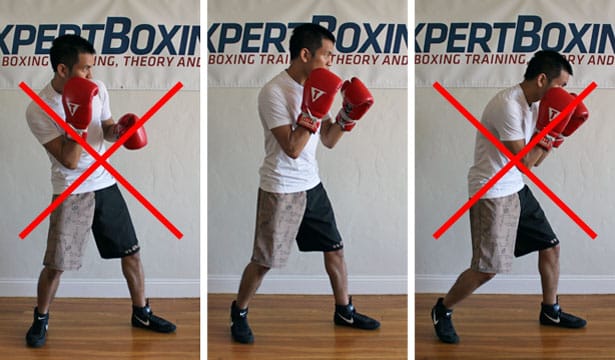
The spine was made to hold you straight up.
This is actually a very basic observation about human anatomy that many people still don’t understand. Your spine is what holds you upright to make you stand tall and balanced on 2 legs. A straight spine is our body’s MOST NATURAL and MOST EFFICIENT POSITION! Once you understand your body’s natural position, your ability to move it will improve.
The straighter spine has better balance.
Having a straight spine is the easiest way to be perfectly balanced. This is because your body is perfectly stacked requiring minimal energy to stand. Your body is divided in half perfectly down the center, easily distributing your weight between both feet. The moment you tilt your spine in any direction, you will naturally be more inclined to fall in that direction and less able to move in the opposite direction. Even if you DO manage to balance yourself with a tilted spine, this is not a “true balance” because it requires you to offset more of your body to one side and easily comes off balance as you move even the slightest amount.
Having a straight spine is the easiest way to have your body perfectly balanced from top to bottom, allowing you to move or spin effortlessly without having to re-balance yourself!
A straighter spine moves and pivots easier,
WITHOUT losing balance after movement.
The straighter spine is easier to move/pivot.
One thing I like to teach to my fighters is “spine awareness”. You have to be aware of your spine because it’s your axis of movement. If you want to move, you have to move the spine. If you want to pivot, you have to pivot the spine. This doesn’t mean the spine generates movement; I mean that the spine is your POINT OF MOVEMENT or AXIS OF MOVEMENT.
Suppose I want to throw a powerful punch. If I maintain a spine awareness and focus on rotating from my spine, the punch will be well-balanced and easily powerful. If I put too much focus on my punching hand, I will naturally have more weight on that side of the body and end up being off-balanced.
Suppose I want to move around the ring like Muhammad Ali. Watch footage of him and you’ll see that he has a very straight and tall spine when he bounces around the ring. This is what allows him to jump around and throw deadly punches. Many fighters with good footwork will have a straight spine when they move.
Now this doesn’t mean my spine ALWAYS has to be straight.
Not at all, look at Pernell Whitaker. When he grounds his feet his spine tilts all over the place. The important thing is to understand the relationship between your spine and your ability to move. You might straighten your spine to move into range, then plant your feet and tilt your spine for punches/slipping, and then straighten again to move away.
A straight spine is for foot movement.
A (minimally) tilted spine is for head movement.
4. Relax Your Upper Body
There is no such thing as “lower body movement”,
there is only “body movement”.
Your upper body and lower body (should not) move independently.
This is another one of those things that people don’t understand. The lower body is not a separate entity from your upper body. These can be EXPLAINED and DESCRIBED as two separate things…but it has to be moved as one. Once you understand how body movement works, you will see why there is no “upper body” or “lower body”—there is simply one “body”.
All (powerful) movement is generated from the core. Let’s say I wanted to type a comment on a YouTube video or scratch my nose; well, no power needed therefore no core is needed (meaning I can do these things without disturbing my lower body). Now what if I wanted to run fast or throw a punch? Well NOW my core is needed. I cannot run without using my arms, and I cannot punch without using my legs.
The core is required in all powerful movements because powerful movements are usually a PUSHING or PULLING force generated from your body. And the core is needed to “ground” your body (usually against the ground) to give you a foundation to push or pull from.
This then makes all your extremities (arms & hands, legs & feet) AN EXTENSION OF YOUR CORE. Which then means…that you cannot move one without the other! Get it? You cannot move your legs POWERFULLY without moving your arms. And vice versa, you cannot move your arms POWERFULLY without moving your legs. Likewise, you cannot GENERATE POWER with one and not the other and you cannot RELAX one without relaxing the other. This is why having good footwork WILL INCREASE YOUR PUNCHING POWER.
You cannot (POWERFULLY) move one part of your body
without moving the rest.
A stiff upper body restricts lower body movement.
This might be a big “AHA” moment for some of you. For everyone else, try this:
- Try walking a couple steps just as you normally would. (Notice how your arms naturally sway to counter-balance your lower body.)
- Now try doing the same thing BUT HOLD YOUR ARMS in a rigid position like down by your side, as if your upper body was stuck in a frame. (See how stiff and awkward you feel?)
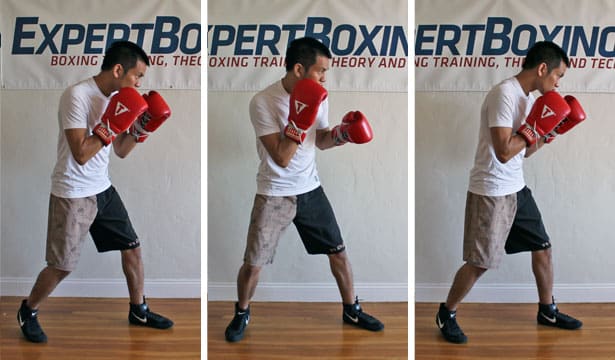
I can use the same principle with boxing footwork! Here I relax my upper body as I move, allowing my upper body to “move” with my lower body (letting my arms swing slightly as though I’m walking). It’s not about dropping the hands, it’s about letting your upper body move and counter-balance naturally with your lower body movement.
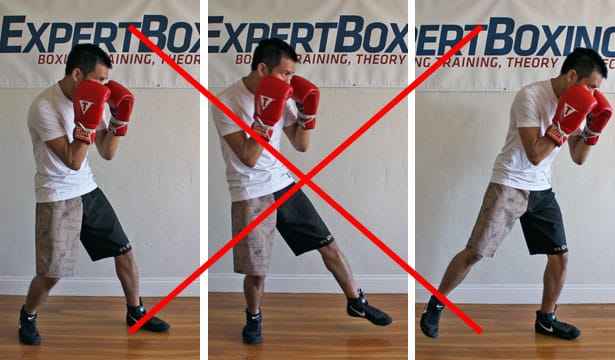
Or you can do it like this. See how when I make a stiff upper body, my body wobbles awkwardly off balance. Holding tension only makes you tired and waste energy; and you won’t move very well either. Many of you look like this, maybe not to the degree of my exaggerated demonstration above, but you do. It makes me laugh to see fighters wobble around like this.
Imagine trying to be agile when you’re carrying a 20-pound bag of groceries. It’s the same way with your upper body tension. It’s hard to move when your upper body is stiff.
Stop trying to hold a frame and let your WHOLE body move!
It’s impossible (or very difficult) to move the upper body or lower body without moving the other. And it’s impossible to hold tension in one while relaxing the other. Stop worrying so much about keeping a perfect defensive position. (Besides, good defense comes from defensive movement, not “defensive position”.)
Boxing is about movement first,
position second.
5. The BALLS OF YOUR FEET are the FIRST ON and OFF the ground
Always land or push off
using the balls of your feet.
When going forward, land the BALL OF YOUR FOOT FIRST.
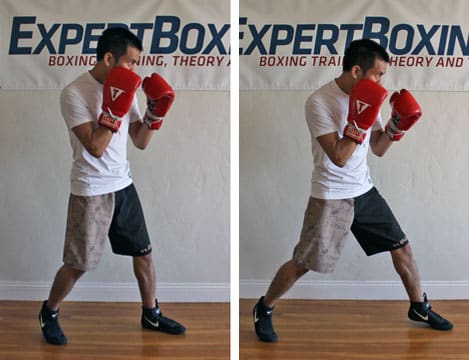
See how the ball of my foot touches the ground first? This is what looks slick. It allows me to quickly have 2 power points on the ground which can be used to push or pull me again, or ground me for punching. I can also use that front ball of the foot to return backwards for faster in-&-out type of footwork.
Do NOT step forward with your heel.
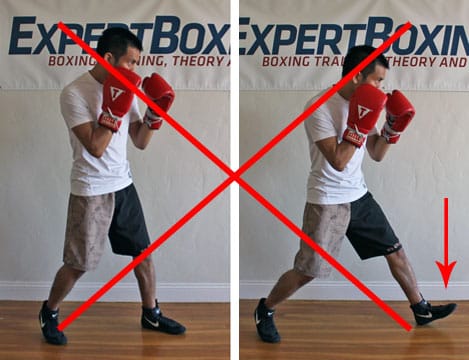
BADDDDDD! Terrible.Terrible.Terrible. Your footwork has the grace of a dictionary when you move like this. It’s like your foot is a giant ugly book going *KA-LOMP!* all over the place. Stepping with the heel first has far less control because you can’t ground or apply force in any direction until the ball of your foot hits the ground.
Naturally, heel-stepping makes you a slower mover because your forward step has 2 sequences of movement (heel step & toe step) compared to someone who steps with the ball first (toe step). You also pay a price for being less grounded; you fall off balance when pushed and can’t throw punches as powerfully when your heel plants first.
When going backward, PUSH OFF THE BALL of your foot.
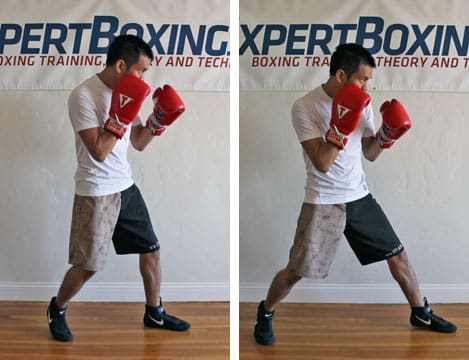
Reverse the rule when you foot leaves the ground. When your foot is leaving the ground, PUSH yourself using the ball of your foot. This makes the ball of the foot the last to break contact with the ground, AND MORE IMPORTANTLY, moves your body away more powerfully from its original position.
Do NOT fall back off your heel.
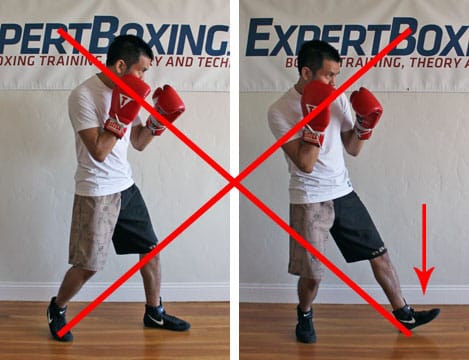
This is SO BAD! SOOOOO UGLY! I hate seeing this. The reason why this happens is usually either A) you were running scared and forgot about technique or B) you don’t know how to move correctly. The reason why fighters step off with the heel is because they were falling towards the other leg, instead of pushing themselves towards the other leg. When you want to go backwards powerfully and with more control, push off with the ball of your foot.
Toe-stepping means you’re stepping properly.
Heel-stepping means you’re falling.
Stepping ON and OFF the metatarsals increases control, power, agility.
You have to remember this rule when you shadowbox and do footwork drills. When you leave the ground, push with the ball of the foot. When you land on the ground, reach with the ball of the foot first.
It’s not about being on the balls of your feet all the time,
it’s about USING the balls of your feet all the time.
The reason why we avoid using the heels is because the heels have no muscle so it can’t give you any control. The more you use the balls of your feet, the more balance, control, and power you will have. Even when your feet are flat on the ground, you should still have your weight on the ball of the foot!
Footwork is one of those things that looks plain ugly when you do it wrong. Stepping on and off your heels makes your footwork look amateurish and ungraceful. Watch how cats move so powerfully and gracefully; they step with the FRONT of their feet for grip and control, not the back.
6. Narrow Your Stance
Narrow stances can take bigger steps and pivot easier
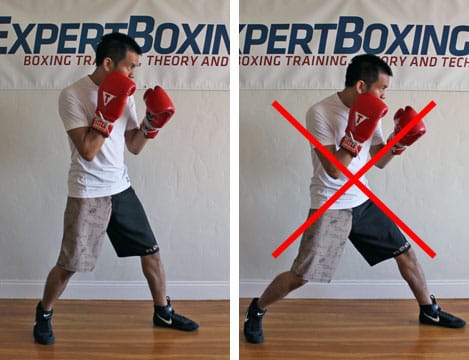
Try standing in a both narrow and wide stance and see which stance steps farther and pivots wider. See how easy it is for a narrow stance to take bigger steps and make big pivots? Having your feet closer together gives you more room to move and makes it easier to pivot.
Wide stances uses more energy and offers less range of motion.
If you’ve read my other guides on boxing stance, then you know: the wide stance is definitely harder to take long steps and pivot. Sure you CAN take long steps but you’ll most likely end up jumping which uses more energy. You CAN do a wide pivot but that requires you to have more weight on the front leg and be off-balance.
Aside from making it harder for you to move, a wide stance will make it harder for you to stand. A wide stance will have your legs splayed out to the side which requires you to spend more energy just to hold yourself up (because the legs are exerting some horizontal force against each other). So if you ever want to take a break, put your feet closer under you and see hip much more relaxing it is on your thighs and hip muscles. This is why tired fighters end up walking, but the narrower position allows them to rest their legs.
You KNOW your stance is too wide
when it’s tiring to stand still.
Develop your boxing footwork using a narrower stance.
This isn’t a rule to tell you that wide stances are bad or that you can never fight with a wide stance. This isn’t true at all. Many pros and olympic amateurs will use a wide stance from time to time. But for a beginner, using a narrower stance will help you do certain things easier (like pivoting and taking big steps).
It’s not about whether a narrow stance is better than a wide stance. It’s about WHY you use a wide stance. Many beginners ARE FORCED to use a wide stance because they don’t know how to ground their weight properly. You don’t use a narrow stance because they don’t know how. In their case, having a wider stance won’t improve their balance, it only prevents them from falling—BUT THEY ARE STILL OFF-BALANCE!
A wide stance doesn’t improve bad balance,
it only hides it.
Remember my tip up above about the straighter spine? Many fighters stand with a tilted spine when they use a wide stance (especially when they mimic Floyd Mayweather’s shoulder roll). Some of them argue with me and say, “What do you mean I’m not balanced?! Look at me, I’m not falling over!” Well just because you’re not falling over doesn’t mean you’re balanced.
LEARNING how to fight with a narrower stance teaches you, or better yet, FORCES YOU to develop your balance awareness. It’s like taking the training wheels off your bicycle and forcing yourself to stay up using good balance as opposed to having your feet so wide that you can’t fall.
*** QUICK TIP: some of the slickest footwork is easiest from a narrower stance. Watch Muhammad Ali, Pernell Whitaker, etc.
7. Smaller Steps
This is another of those things I have to keep yelling at beginners. Just about EVERY BEGINNER is guilty of taking over-sized steps. Actually, I would even say that you are NO LONGER A BEGINNER the moment you learn how to take smaller steps.
A typical beginner is overly anxious to cause damage so he’ll jump far deeper into range than he needs to be. Then he’ll realize the danger he’s in and jump FAR outside of range in panic. Now using anxiousness as excitement, he jumps back into range again and repeats. Beginners have no concept of reach and think of footwork as nothing more than IN-AND-OUT! (Watch my video above to see my demonstration of smaller steps.)
It’s not about going IN AND OUT.
It’s about going (barely) IN and (barely) OUT.
Great boxing footwork uses the SMALLEST distance possible.
The goal is not to cover as much distance as you can. Distance is a game you will never win. In fact, you CAN’T win the game of distance. Because the game of boxing is punching for points, not running for distance. The more time you spend moving your feet, the less time you spend moving your hands.
Stay within the edge of range, instead of wasting energy to go unnecessarily far beyond the line. Use your entire reach! Extending your arm an extra inch requires much less energy than moving your body an inch.
Bigger steps always requires more energy and more time. It doesn’t matter how athletic you are, you will NEVER be as quick as your opponent if he is taking smaller steps than you are! This isn’t a matter of skill or conditioning, it’s simply a matter of who is doing more work. Smaller steps require less energy and will be easier to control. You can make many directional changes and tricky cuts and pivots with small steps. A bigger step will only leave you vulnerable to punches. Better opponents fight very well at range and will counter you easily if you jump in too far. In fact: the better your opponent, the smaller and quicker controlled steps you will need.
You will never be quick enough
if your goal is to step farther.
8. Learn to Walk
I know many boxing coaches will yell at their fighters to “STOP WALKING! Do the step-drag!” but I think it’s important for non-beginners to grow beyond that. Walking is one of the body’s most natural forms of movement. When done properly in the ring, walking is one of the most skillful ways to stalk an opponent or even evade an opponent. The greatest benefit of walking is that it uses very little energy.
Here, I pretend to “walk” around an imaginary opponent (away from his power hand).
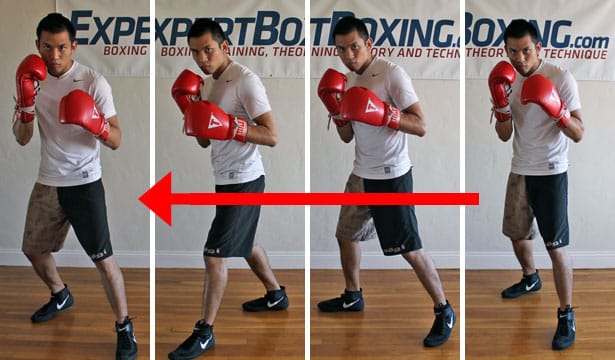
Notice how this isn’t the same walk we use on the sidewalk (with our arms down by the side). It’s simply me walking around with my legs AND relaxing my upperbody to counter-balance with the lower body as I “walk” around the ring. Many pro fighters will use the same move to escape out the side when they don’t feel like using side-steps. (Please watch my video for a better demonstration.)
Walking saves energy!
The first benefit of walking is that it saves energy. By having your hips more under you and not jumping around, you can move and twist and turn in all sorts of ways quickly using very little energy. No more jumping around on one-leg or two-legs, just go for a walk. When you’re out of range, walk. Or lets say an opponent as attacking you; there’s no need to jump backwards, you can simply walk backwards which takes the steam off his punches because you’re not giving him a solid target. Walking is a great way to save energy AND keep you relatively grounded for punching, defending, or pushing purposes (like in a clinch).
Walking is slick!
Yes, walking makes you really slick. Jumping around and darting back and forth looks impressive because it’s so athletic but walking is one of those things the pros do really well. You KNOW you’re facing a legit fighter when you see him walking you down and calmly slipping and rolling under your shots. It will be scary at first to try and fight without jumping but you will eventually develop these footwork skills without enough practice.
Watch the most slickest fighters and you’ll see that they’re usually walking and not jumping. I don’t want to write a guide ont his awesome art of fighting footwork so you’ll have to experiment and watch videos for yourself. The best walkers of the modern era are probably James Toney, Pernell Whitaker, those type of guys.
The fighters with the slickest footwork,
are incredibly skilled at walking!
9. Pivot Your Feet
The direction your feet are pointing
is the direction that is easiest for you to move.
Naturally, everyone’s feet is usually pointing forward so moving forward is easy. The hard part comes when you try to move backward.
Moving backwards WITHOUT pivoting the feet.
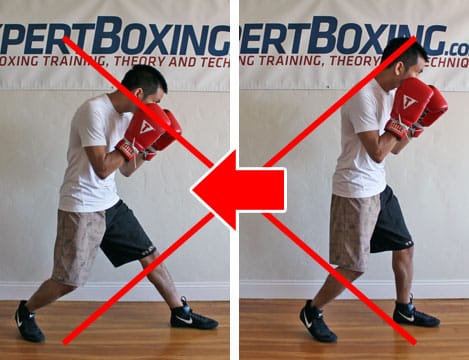
This is the most basic way to move. You simply push yourself back. It’s not wrong but it’s not the fastest way to move back.
Moving backwards WHILE pivoting the feet.

Now here instead of pushing myself straight back, I pivot my feet first. Now I know it seems like I’m adding an extra step and making it slower but actually this is much faster than trying to push myself backward. The reason is because the moment I pivot my feet, my body BEGINS to fall in the direction of the foot. And so even though it’s 2 movements (pivot, then step) instead of a single push, it will actually take much less effort.
The body naturally falls in the direction of your feet.
This is why your feet are in FRONT of you, to prevent the fall.
Wherever your feet point, is where your body will go!
It’s really a simple fact of human anatomy. The trick is to point your feet in the direction you want to go. And if you want to change directions, then simply pivot your feet in the new direction. Once you understand how your feet work, you will see that it’s easier to go IN-AND-OUT movement simply by pointing your feet forwards and backwards and then “relaxing” in the direction you want to go. If you point the feet correctly, you no longer need to push yourself back and forth.
To go IN & OUT quickly,
simply pivot your feet back and forth and “release your body”.
10. Lower Your Hands (ADVANCED TIP)
Here goes another pro tip. And this is NOT RECOMMEND FOR BEGINNERS! Read on…
You must lower your center of gravity to have better footwork.
The lower your center of gravity, the easier you can move around in all directions without losing balance. The real challenge in developing good footwork is actually managing the upper body! Developing the lower body is the easy part, you can do conditioning and drills and all that stuff but the problem is your upper body. The upper body makes you feel like a tower and always seems to fall over when you use fast footwork. Even if you manage to spread your feet out wide (to lower your center), your upper body might STILL be easily pushed off balance.
Keeping the upper body balanced
is what makes boxing footwork so difficult.
The trick to managing the upper body is to LOWER ITS CENTER.
The more tension and more energy you carry in your upper body, the easier you fall off balance. And the bigger your upper body, the easier you fall off balance. The reason is simple, the upper body is a “weight” that sits high above your center of gravity. The “heavier” your upper body weight, the harder it is for you to move without getting off-balance. So how can we lower the upper body without tilting the spine and coming off balance?

Instead of using a high guard which raises your center of gravity and makes your head & shoulders area really heavy. Having your hands really high also magnifies the tilted spine effect when you slip and makes it harder for you to slip without losing balance and wasting energy.
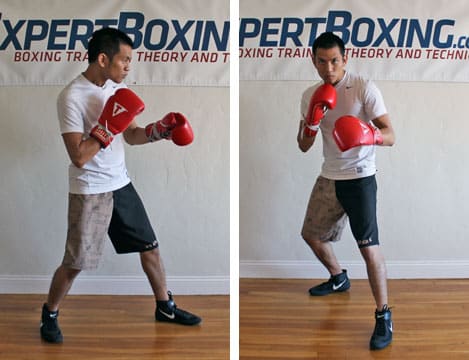
Try dropping the hands a little bit like this! Now you don’t have to drop your hands all the way down, but maybe you can drop them to chin level instead of forehead level. This also makes it easier for you to protect your body since your elbows are down.
Lowering your hands lowers your body weight and allows you to move around easier. You may have seen pro fighters fight with their hands down at the sides especially when they’re trying to dart around the ring. The reason is because they are using their hands to counter-balance their head movement and quick foot movements. You can use your arms for balance the same way a cat uses its tail for balance.
Lowering your hands helps you stay balanced,
so you can move your head and body more.
Other guides on boxing footwork:
- Muhammad Ali Boxing Footwork Technique
- 10 Advanced Secrets to Balance and Footwork
- Balance Secrets from a Dancer
- Best Boxing Shoes Review
- Basic Boxing Footwork Strategy
If you’re looking for more serious boxing footwork techniques and exercises, check out my: Dancer’s Footwork for Fighters.






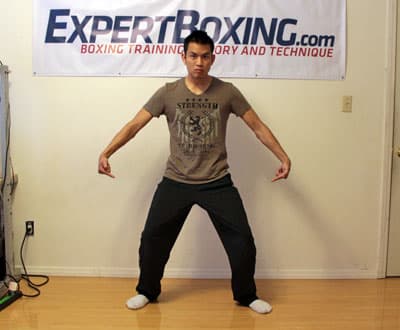
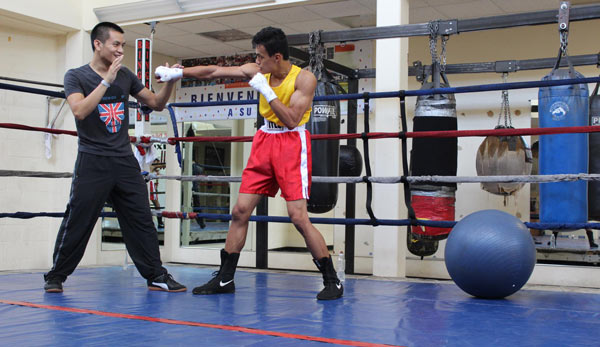

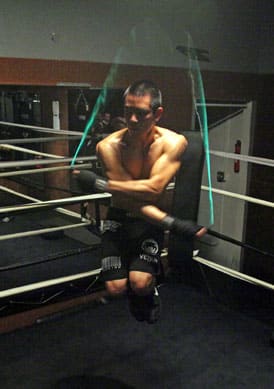
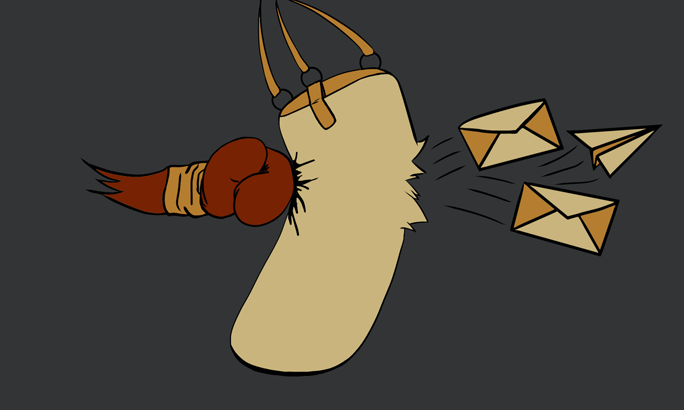
This is really a beautiful article and is one that I have really been hoping for. I love the tips and have really focused on many of these aspects. I have one question, I do a LOT of jump rope and have really fallen in love with what it accomplishes and find myself able to box for hours with a lot of the credit going towards the jump rope. I have tried to find the most efficient way to jump rope and sometimes use different types of steps to accomplish different things, so what are some tips to how to move your feet when jumping rope to get the most out of it (I usually do a switching type step with each jump or with my feet together a pivot in a different direction each jump).
There are many fancy jump rope tricks out there. I would recommend for you to watch youtube and learn more of them. I usually vary between about 10-20 tricks when I jump rope. This allows me to work different parts of my coordination and muscles.
I’ve been a long time BJJ guy since 2006 pulled out from the dojo due to life time injuries from this big 2nd command instructor, going to a safer dojo does mostly BJJ all week, 1 weekly night 30 minutes strike sparring-hand/feet, and 1MMA night I haven’t really experienced yet, 1st lesson strike class I fell down concussed by round kick, 2 class a black eye all dizzy riding back home , 3 class thinking a must hold my shoulders up to jab barricading sides of my head while punch that failed – with fast hard punches that got thru (NOW) at present I’m thinking about “Footwork” maybe daily training my footwork will make like 80% higher to my boxing standards – what do you reckon! And then Google up to find that out getting me here, I have fast punches that I train on floor 2 ceiling ball also – what I’ve envision was in rocky 2 movie where Apollo trained rocky to that song “eye of the tiger” where Apollo says something like during footwork training to Rocky “relax now – just relax – don’t force it – the rhythm will come – it’ll come now – it just takes a little time” where the other friend says “you can’t train him like a… He has heavy feet” -and I’m wondering about doing the same with that perfect rhythmic song until my mini close steps feel fit being natural and swift since I felt my feet where just too heavily slow! Despite NOT being heavy in weight! – I daily train all my flexibility getting great gains in all positions, now I want to incorporate heaps of footwork thinking this kind of fitness will greatly raise my boxing standards since I’m just like a dead rock in the dojo at the moment, and reckon that boxing has a major place for realistic overall self defense, as a lot of attacks start with hits, despite my age I say I’m a young 45 put wanted boxing ever since I knew combat existed – brain trauma also worries me as my mind is my foremost asset as my other interests speed-reading & memory feats, wanting to remain sharp as possible to the end of time, so I figure as long as I don’t overdo too much of their hard contact sparring as those guys down at my dojo don’t ever go light, even when I ask them to… – I admire how much you share about boxing – thx Jonny
Message here once again to say I never say for certain until tried for results, but I’ve just thought of an idea that might train footwork into speed, what if I slow down the floor to ceiling ball loosing below strap, and then try to shuffle close to it trying to gauge beating its swings touching me by my own footwork, also I once modified an attached light padded strike limb above ball defending its hits doing many hours/days training – but than found in reality a closed guarding was a better bet than any reflexing block – BUT now I’m thinking the floor to ceiling ball as it is to just working at beating the swing back as to give me something to challenge me in racing against it – just an idea, what do you reckon about that idea Johnny?
Did some major word errors (correction:) Message here once again to say I never say for certain until tried for results, but I’ve just thought of an idea that might train footwork into speed, what if I slow down the floor to ceiling ball (loosening) the below strap, and then try to shuffle close to it trying to gauge beating its swings touching me by my own footwork, also I once modified an attached light padded strike limb above ball defending its hits doing many hours/days training – but than found in reality just a closed (guard) was a better bet than any (reflex) block – BUT now I’m thinking the floor to ceiling ball as just work at beating the swing back (giving) me something to challenge racing me > just an idea – so what do you reckon about that idea Johnny?
And another idea to pace faster “Footwork” could be using metronome ticker or rhythmic song played in VLC media player can increase audio by 4X faster till the sound cuts, actually come thinking of it, I have a variant metronome software on my pc that can de/increase many times over which was an old speed-reading program, I’ve never skipped much but I’m sure there be many combos like shuffle-forward/back boxing shift before the rope swings loops you or something, anyhow I’m going to train this hopping to get heaps… of practice till real swift and hard to catch.
Loved the Article, I always learn something when I visit this site. The straightened spine bit was something I hadn’t noticed before because I guess I did it naturally. What do you recommend for guys like me that fight slightly off center-line AKA golden era boxing? Sorta like James Toney, BHop, Mayweather, Joe louis. I find that coming into range, its always safer to be off center-line or control his lead hand(i’m southpaw) and always to leave the pocket off center-line. It seems like the bit of advice about straightening straight up as you are leaving the pocket might put you in countering range. the only way I could see, is if you leave on an angle, kinda how Pernell does. I’m interested to see how your articles will address angles and advanced stuff later on. Thanks
To draw on the center-line theory is a limited way of thinking. There are 2 things you have to understand:
1. The goal is to STILL to be on the center line.
Even when boxers tilt (everyone does it, not just old school), they are still trying to be as centered as possible. The goal was never to be slanted or tilted. Most beginners that try to mimic the off-center theory are doing it wrong and just end up being off-balance. Watch all your favorite fighters (even the ones you listed) and you will see that most of the time, they are relatively straight up. Even when they come off-center to slip most punches, they are still pretty centered and well-balanced.
1a. You ALWAYS have a center.
Just because you’re not straight up doesn’t mean you’re not in the “center”, it simply means your “center” is crooked and makes you less able to move around. No skilled opponent is stupid enough to purposely miss you by aiming for your “imaginary center”. Every (skilled) opponent will treat YOUR HEAD POSITION as your center, and if your center is off-balanced then you will be less likely to evade his attack.
2. Different positions for different situations.
In situations where you need more footwork, you will likely need a straighter spine. In situations where you need more head movement, you will likely rely on a slightly tilted spine. Your spine tilts in all directions and even if you claim to be an “off-centered fighter”, you still in fact have to bring your spine back across the center in order to reach a new off-centered position. Everything is positional. You will need mastery of all positions (centered or tilted), however the one you stay in the longest is the one you will be remembered for. (It’s a similar idea to punching. Every fighter generally throws the same punches but the one they throw the most is the one they are remembered for.)
As for leaving proper body angles when entering and exiting the punching range:
It depends on how your opponent is positioned. If he’s straight up and in position to throw straight punches, then obviously the smart idea is to stay off the center angle. If he’s off-balanced and only able to throw off-angled punches, well then being centered will evade his off-angled punches all the same.
What’s most important is that you are at a different angle from his attack. Too many beginners try so hard to stay off the center and they end up giving their opponent the dominant center angle. But if you’re experienced, YOU CAN MAKE your opponent punch off balance or tilt off center which then gives you control of the center angle. And then you will be the strong dominant one. Because your spine is straight and his is not, you can control his body and have access to a greater variety of punches while simultaneously limiting his angles of punching and body movement (because you’re keeping him off his center).
It doesn’t matter whether you’re on the center line or not. What matters is that you have control of the dominant punching angles while evading his attacks.
Ah okay, thank you, this clears a few things up.
Outstanding article Johnny.
Footwork is everything. The more I realize and implement this, the better results I see in the ring. Just one thing though, when pointing our feet in the direction that we’re moving, in the picture, say we stepped back like three steps, and we want to orient ourselves back toward our opponent. Are we putting our weight on the back leg, pointing the lead leg toward them, and then adjusting the rear leg?
And similarly, backing up like in the photo, what if we wanted to sidestep from that position? Are we adjusting, or correcting the lead leg first to go to our right, and the rear leg first to go to the left?
For sidestepping, I was taught to dip the knees and have the head trace U’s almost. So in the middle of the step, our head would be dipping lower. Does this dip occur when moving forwards and backwards?
Thanks again for all the awesome articles Johnny.
This shit’s awesome
Try the technique and you will see what feels more natural. If I had to be overly technical, I would say:
– putting weight on the “pushing foot” is what makes it pivot
– which then pivots the “free foot”, as your body begins shifting weight towards the “free foot”
In regards to dipping the head, I don’t know why your trainer made that a rule. I don’t see the point unless you’re trying to roll under a punch. I wouldn’t use it as the default rule for moving.
I guess my trainer said that so that we wouldn’t straighten up our knees and be left nowhere to go at the end of movements. I had (falsely) assumed that it was normal, but I guess it’s not really necessary as long as we’re moving properly.
I’ll try it out though. I only ask because what feels natural isnt always natural. Like power punching, for instance. People always want to overcommit or jump into shots at the beginning, for example.
Hey people of pugilistic study: One extremely important thing that seems to be a lost, priceless training drill is shadowboxing. Everyone wants to hit something. But shadowboxing is very valuable because it not only warms up the specific physical faculties used to box but allows a good fighter to practice the techniques ( especially footwork ) but also the other nuances like keeping the chin down, good eye contact, pointing the front shoulder toward the opponent, and dropping the rib cage ( helping to defend body blows ). I remember going to watch Aaron Pryor prepare to make his first defense of the WBA 140-pound title against Gaetan Hart. In addition to sparring and mitt work, Pryor must have shadow boxed 10 rounds during the training session. I think Pryor’s results were pretty good.
Stay Hungry,
M. Lawrence Pineda
Does pernell whitaker use his southpaw instinct and footwork to be so good at slipping?
I’ve never heard of “southpaw instinct”. But yes, his excellent control of his body is what makes him good at footwork (foot movement) and head movement.
I have some questions:
1. Can you explain what you mean by ‘center angle’?
2. Did you cover the ‘pivot your feet’ in your footwork video? (I can’t quite remember)
3. I know you’ve said you wouldn’t want to spar against someone using 14oz gloves. I bought a pair ($40 Title Classics). Would it be okay to spar with these gloves? I spar at my Jiu Jistu gym, and I’m about to sign up for Boxing. How much of a difference does the extra 2oz make?
4. Would the $35 Title Boxing shoes be a fair choice? (I’m broke, can’t you tell? LOL)
Thank you in advance. Keep it up Johnny! This site is the biggest help to aspiring fighters.
1. When I say “center angle”, I’m referring to the straight direct angle of attack between you and your opponent.
2. Yes, I did.
3. I only know that 14oz is not cool for me as well as many other fighters. I don’t know if it’s ok for you. YOU WILL FIND OUT SOON ENOUGH!
4. They’re better than running shoes but probably not as good as say, $50 Nike boxing shoes.
what am i supposed to do about my opponents footwork, about what he does? Can i make him walk into my punches by firing punches where i can see him moving.
With the right skill and timing, yes that’s possible.
Question: How can I double up on my right hands better with the same punch two different punches or to the head or the body to surprise my opponent to set up and land body shots.
And P.S. by the way I have came to understand that body punching is just half the work done that body punching is nothing without proficent and sucsessive head hunting with uppercut or overhands. Is this true that head hunting is the icing on the cake to body punching dropping the hands/ guard to exsploit with head shots?
This is a really handy section, I’m sure it’s going too answer a lot of questions. Footwork is one of the hardest aspects of Pugilism to understand and there’s not much written on it. It’s safe to say I learn something new every time I log on too expertboxing.com!
Thank you very much your work
You are my hero !!!
I AM YOUR HERO!!!
I don’t know if this means off center, but what about people that fight with more weight on the backfoot? like 60/40 on the backfoot?
I generally don’t agree with a 60/40 weight distribution but this guide is not about that. This specific article is focused on the tips up above. A will say that a 60/40 weight distribution will definitely affect your spine and your footwork.
OK to make sure I understand this
When you say straight spine do you mean to have the back literally straight or to stand up straight because I “lean” slightly over my right side (head just over my right knee) but keep straighten my back fully in that position so is that good?
I meant to do both: straight spine, and have it straight up (as demonstrated the pictures and video). It’s actually very hard to have a perfectly straight spine while tilting it over. You’d have to be offset elsewhere in your body to balance it out.
what some stores that I could go to to get some quality boxing shoes?
titleboxing
Johnny/All,
I am in search of a new pair of boxing shoes… I currently have Everlast’s Sweude (sp?) Boxing shoes created 2010. I like the lightness of the shoes, but they are difficult to get on, and kind of dated/beat up. I like shoes that cover my ankle (Mid to high)… Do you have any suggestions?
Appreciate your opinions
Rob
I like Nike
Hi Johnny
Great article as ever.
What naturally should follow, however, is a guide to good boxing shoes please!
I’ll do what I can. Unfortunately, I’ve only tried 2 brands so it’s not a fair comparison.
Good article. Also, Johnny what is the name of the Title gloves that you are wearing is it the TITLE Classic Lace-Up Leather Training Gloves.
Yes, it’s the Title classic.
whats better boxing shoes or wrestling shoes? can wrestling shoes be a good substitute for boxing shoes?
The ones I recommended in the article. The ones for the sport you’re doing.
Hi Johnny and everybody else!
Ive been boxing for a year now and Im looking for my first boxing shoes. I think I prefer mid or low shoes. Im currently looking at Rival GSX Guerrero, Nike Machomai or some Adidas shoes. Any tips on this matter? You dont have a shoe review do you?
LOVE the site, keep it up!
I don’t have any shoe review because I’ve only tried 2 or 3 brands at most. I like Nike the best.
Okay, thank you, Ill check out some Nikes!
So guilty of leaning in. In fact, its only since I’ve started doing karate for fun I’ve been picked up on it. Wish I’d known this before.
Cheers,
John
Great video. What shoes are you wearing in this vid?
Nike Lo-Pro boxing shoes.
I have just subscribed to your videos on youtube by the way, do i have to pay for them? Becuase I am on a bit of a shoestring budget.
No you don’t. Youtube is free.
Hey Johnny,
Good article. The only thing is the lateral movement where you cross your feet. It is not good practise to cross your feet as you will get caught off balance.
That “movement” is what I call walking… a commonly used move by experienced fighters, amateurs & professionals. If you’re slick and skilled about it, it offers many benefits. But if you’re a beginner, then yes it will leave you off balanced. Don’t do it if it doesn’t benefit you.
extremely inciteful article, thank you very much for all your articles and videos johnny, they are amazing for the boxing community
Thank you, Stephen.
I was looking at shoes on title boxing, and then wrestling shoes on eastbay and some shoes are the exact same on title boxing that are under the wrestling section on eastbay
Wrestling and boxing shoes can be very similar and sometimes even the same. As long as you get shoes that are meant for boxing, you’ll be fine. If you get anything else, that’s on you.
https://www.youtube.com/watch?v=rRT4ikQgO8w&feature=related
what do you think of the windhshiled whiper?
and what do you think of roy jones skills noted on youtube and funniest boxing dodges too?
It’s a commonly used move. It works when used in the right situation. Roy Jones is a great fighter.
and as well while i am fighting a counterpuncher i will test his defence by continually attacking him to tire him out getting him to overuse his defence then move in for the kill. do you think this is a good modus operendi?
It works when used in the right situations against the right opponents. It won’t always work though.
thanks for all the hard work u have put into this site, I’m sure u knw it’s helpful but I don’t think u fully realise just how helpful it actually is, I’ve gt into boxing at a late age (23), and wen I first started I thought I was good, until I gte beat an had to address my faults, over time I started noticing my faults an rather than improve and fix them I was letting them beat me, over time it bothered me more and more, eventually getting to the point were I was wondering if boxing was for me, then I discovered ur site an over time I’ve begun to realise I was tryna run b4 I could walk, now over time I’ve gte a lot better than I was in the space over around 3 months, I I knw I’m getting better evri week, it’s all down to ur site, u c the people who train me arnt the types to tell u were ur going wrong, onli what ur doing good, an tbh they just expect u to knw what to do from the beginning, but ur site has given me a bit over direction for wen I’m in a busy gym, so thank u again and I’ll let u knw wen I’ve progressed to fighting standards 🙂
I’m curious if Vibram 5 finger shoes would be anything like boxing shoes? I wear them all the time for running and lifting, and they are as you describe, thin souls, and you are suppose to use the balls of your feet for every movement. They have no support, but they also build up and strengthen your natural support.
Buy both and see for yourself.
i was reading an article and it said you shouldnt move your feet without a purpose and too many beginners move there feet without a purpose, what are your thoughts johnny?
I can expand on that. Don’t do anything without a purpose!
Perfect thank you, I have been looking for a article like this for a while as I have awful footwork, and really need to improve. I have a big right hand but can never land it due slow and clumbsy footwork. I am left footed but right handed would this have an impact? Thanks again.
No, keep training.
hi Johnny
thanks a lot for your concern about boxers,and helping them.I am a beginner n have been trained for boxing for the last 4months. Johnny i want to build my career as a professional boxer,but many a times i get disappointed with my height it’s 5’4 ft.n i weigh 53kg.So i just wanna ask you, if there is any possibility to build career in boxing.But yet i do have the guts to fight n have the potential to go through all the boxing training effectively n efficiently.So i just wanna know whether my height will be enough to do boxing.
thanks a lot once again….
Pro boxers are usually shorter than you think. If pro is what you want, then that’s what you’ll have to do. Give it a 100% and find out your true potential.
Hey Johnny, can you make an article and video on ANGLES? I’m having trouble understanding. You always have great picture diagrams that are very useful.
Yes, I can!
another nice article to read after being absent in this website for a while now. special mention on the boxing shoes, since a lot of guys in our gym wear athletic shoes instead of boxing shoes for training. according to them they reserve boxing shoes for fighting since it is expensive according to some and they just use regular shoes destroy in training. other people there jog first outside before boxing so they wear running shoes or should i say use the same shoes to save time.
I do wear boxing shoes an adidas box hog for training. great article but the video doesent work, so I didnt had the chance to watch it 🙁
ive seen the video and read the article, very nice idea about footwork. After observing the professional MMA athletes specially in the UFC and other MMA fighters most of their footwork suck. I didnt mean no disrespect but almost all of them dont know proper footwork, only a handful of fighters know proper footwork, GSP has decent footwork. is it because most of them learn boxing from MMA gyms instead of boxing gyms?
Boxing shoes should not be used outdoors (they’ll wear out very quickly if you do that). With that said, boxing shoes are for boxing. If you want to wear something else then you can. It reminds me of high school kids playing basketball in running shoes so that their Air Jordans don’t get dirty. It’s up to you. If you want better performance, use the better shoes. If you care more about saving money, then don’t.
Most fighters have crappy footwork because they know nothing about it. There are very few coaches who understand where balance and footwork come from. (And the answer is NOT just ladder drills.) It takes years to develop balance awareness, balance strength, and balance skills. With that said, I think MMA guys have less footwork skills because their sport isn’t as refined as boxing. Typically, the average fighter develops striking and defending skills first and then movement is the last thing. And boxers (even amateur boxers) will often have many more fights than even an entire MMA guy’s amateur/pro career.
Are Ttitle boxing shoes good?
– a loyal boxer
I don’t like them. The ones I tried 2 years ago felt really cheap and I haven’t seen anything to convince me they’re better than the Nike ones I have now.
do you know of any good priced ones? and the place to buy possibly online?
because i don’t have a lot of money and feel the high tops ones are good and want a pare that works instead of wasting my money
I like Nike and I get them from Titleboxing.
thank you
I’m sorry man, but this article and accompanying video really do nothing to further demystify the art of good footwork. For a complete novice, this article would be a fantastic starting point but for an actual, experienced amateur (whom you brazenly state typically has “terrible” footwork), it’s perfunctory stuff they already know. How about giving tips about foot placement when a conventional fighter fights a southpaw? When it’s appropriate to keep your foot on the outside and when, in the case of Andre Ward vs Chad Dawson, when it’s effective to keep your foot inside when stepping in? How about talking about changing angles and how to circle away from someone’s power? How about escaping from a corner, using your jab with appropriate side stepping to combat an over zealous opponent? My point is is that you play it safe and give generic advice. Obviously, you have some experience with the sweet science (you can see it in the way you move) but if you’re going to make a bold statement about how “terrible” the average amateur’s footwork is, you need to offer insight (there’s an eBook on Amazon by Jack Slack that does this; I’m not advertising, I’m simply giving a point of reference).
The article is written for those who can benefit from it. If it’s too basic for you, then I applaud your skill. Please pass by but don’t accuse me of “further demystifying the art of good footwork” when I’m starting with the basics to help those who aren’t on your level.
What you’re talking about is boxing strategy and footwork strategy which is an entirely different can of worms. I wouldn’t expect the ability to carry out that strategy without first having the more basic ability of proper footwork TECHNIQUE.
I don’t enjoy playing it safe at all. Every time I want to write something totally interesting, I get comments from all the newbies and it makes me realize how much basic help the general boxing public needs. I wouldn’t invest my time in the absolute basic articles if everyone was as properly informed as you.
In regards to the orthodox vs southpaw match-ups, I have a large guide and some Youtube videos addressing that aspect of boxing. My plan for the future is to work my way up into the more advanced boxing guides covering both footwork technique as well as footwork strategy. Keep making requests because I definitely will catch up to them. THANK YOU!
Bryan.. really?
“For a complete novice, this article would be a fantastic starting point”
you should’ve stopped there. Obviously you have some experience with the sweet science.. you talk the talk, but can you walk the walk? It’s not even about boxing skills.. it’s about whether or not you have what it takes to make a website, invest thousands of hours for free to try and help thousands of other around the world.Yes i know.. you can’t cause you don’t have time for it blah balh blah… please man.. if you want to hate, go on youtube or something, where all the other haters are and you guys can take turns hating on each other. Johnny’s doing a great service to many people around the world. What are you doing?
I didn’t come on this Johnny’s site to troll or hate on what the guy’s doing; I came on this site as someone who’s been training for years and is always looking to improve. The introductory paragraph had me believing that he was going to break down actual foot work to be used when either sparring or fighting. He really didn’t do that. I wouldn’t mind if he didn’t state how “terrible” the average amateur’s footwork is. Furthermore, I know how it is to throw yourself out into the world and find rejection or people ready to tear you down–I’m a college grad and a published writer so I have some idea of rejection and blunt criticism from editors who only care about the product and not how hard you actually worked or how many hours you spent etc. Just because I don’t gush about his article and video, doesn’t mean I’m trying to make myself feel better; I’m trying to give effective feedback so he can understand what a potential visitor, one who trains day-in & day-out in the art, is looking for. Obviously, it’s just my opinion, but to simply write off feedback as hidden jealousy is inane and childish.
Hey johnny. Ur right I do have a wide stance when I’m sparring. Especially when coming forward .
I tend to be far n lean over n leap in with a jab . Sometimes I can land
It but sometimes I get cought leaping in. How do I force myself to shorten my stance n take smaller
Steps without losing my balance, especially when trying to close the distance. I notice often this causes me to put too much weight on my front leg which makes it hard to advance. Thanks
Miguel
The easy answer is to say, “stop being off balance and you won’t have balance problems”. The hard answer is, “develop your balance awareness so you won’t come off balance”. This can be done with the jump rope, shadowboxing, and many other specific footwork drills. It’s not a problem to fight with a wide stance if it’s an advantage. The problem is fighting with a wide stance because you’re unable to stand otherwise.
Another helpful tip is to take smaller steps. The less you have to move, the less likely you are to come off balance.
can u please make a video on how to skip rope as soon as posible please really apreciate
It’s already out, look up the youtube videos!
Thanks johnny. Appreciate it. Would you recommend buying the fast feet from title boxing?
I want to fix my balance I often overstep , or stance too wide or stance too sideways .
Thanks
It can be helpful for a month or so and then afterwards you won’t need it anymore. Or you can also manually adjust yourself through shadowboxing. It’s not necessary but it can help.
Another great nugget of wisdom. Thanks
Hey Johnny,
Thank you for putting in the effort to help out people like myself that are new to the sport. I have my first bout in a couple weeks, and I’m excited to utilize all I have learned. Your articles are interesting, witty, and most importantly informative. Thank you for your hard work.
I love this article. I am getting back into boxing. The part about jumping rope, smaller steps, and walking helps a lot. It’s especially helpful for people that doesn’t do boxing everyday and we all learn differently and I like that I can circle back here and put some checkboxes on what to work on next.
Thank you! I am a fan and will def bookmark this site.
Hi Johnny
Excellent article mate. I was just wondering should your footwork always be completely relaxed (no tension in your legs, feet etc) even when your opponent is coming at you aggressively and your trying to change direction fast and get out of there quickly with your feet. My coach always tells me to relax my upper body for more speed so would this do the same for the speed of your footwork??
Exactly… relaxed. Make sure you know the difference between tensed, relaxed, and collapsed. You want to be right in the middle which is relaxed. You should still have control, not just let your body fall all over the place.
Wow! I’m always awkward with foot work thanks for the tips!
Thanx for the tips, my trainer always gives me grieve when it comes to balance. I am sure this will help.
Hey Jon: You’ve got a great, accessible, athlete-oriented website. Keep up the good work! Stay Sharp,
M. Lawrence Pineda
oi mate i got a question i only have heavy work shoes with steel tip i dont have that much money so i only buy those shoes(for my career) are those any better than those tennis shoes or are they real bad for boxing i cant afford a 25$ shoes so what would you recomend fight barefooted or with the steel tip shoes? great website btw
I recommend boxing shoes. If you don’t have access to that, anything that lets you move athletically would be recommended.
sorry to disturb but as i said do those shoes lower the power you can transfer or not.
I would say yes, any shoe with a thicker sole will probably decrease the amount of power you can generate.
man said walk in boxing u pussyio
Hey johnny,
I was wondering if you can do a writeup on muhammad ali’s footwork ? Like how he balance himself and jump around and even counterpunch while moving. Would really love to learn his footwork and add it into my arsenal!
Yes, I can definitely do this. Muhammad Ali’s footwork technique was very different from most boxers which I think I understand very well. I’ll make a video on that eventually.
Hi, Johnny N, I knew about your website a couple of days ago and have it very good….It is the right website to learn boxing and I’m doing it….I’m 21 of age and have started learn boxing by your guide.
I want to join you in gym..I’m from Pakistan….have really started to be boxer and chose it my future…
tell me everything how to join international and professional boxing..
Find a boxing gym with amateur boxers and start there.
Regarding the shoes, what if you are doing both plyometrics and sparring in one session. Is wearing boxing shoes ok for this? It would be terrible to have to switch shoes in between.
Also, jumping ropes with boxing shoes…you lose the absorbtion…is that ok too?
I use my boxing shoes for everything in the gym. They work fine for all exercises inside and outside of the ring.
Wow great article thank you so much, I’m an MMA fighter who is severely lacking in the standup department. My foot work has always felt cumbersome and unbalanced. I was in bed reading this article last night and I had to get up and shadow box after reading the part about pointing your toes in the direction you want to move. So simple yet I could feel the difference immediately as I moved around the room… felt like I was gliding compared to how I conducted movement before. Thanks for the tips! I can’t wait to get to the gym and and reshape the way I move in a fight.
I’m happy for you, man! And yes, that tip can be such a huge difference when done correctly.
Can you use wrestling shoes for boxing? The asics wrestlig shoes for example, is it not good with to much grip? I’ve seen alot of boxers use wrestling shoes.
Hi…
I’ve just started boxing recently..
I want to do some foot work drills at home,,,can I use the regular exercise mat or wrestling mat together with boxing shoes for this purpose…
btw your website what encouraged me to start and I thank you so much for your work
Yes, you can. I’m honored you found my website to be the motivation you need. Keep training hard and good luck!
hey the lower guard thing is biting thumb ok for that lower or do you mean lower than that
Are those the title pro fight gloves you’re using? I’m planning to get them but I heard they’re pretty stiff.
These are Title Boxing Class Training gloves. They’re ok but I prefer using other gloves. I only use these for making videos.
Do u hav some footwork drills I can practice other than jumping rope???
I have some on my Youtube channel. There are also some more drills on my “EASY Boxing Workout” article.
https://www.youtube.com/watch?v=x0vqh3DNFMY
Hi Johnny N
Quick question just so I have a goal to work towards in practice, using the step-drag technique how fast should I be able to move across a ring, that’s 20 feet across?
Plus do you know how fast professional title fighting boxing can move across a ring using step-drag? Just for reference.
Thanks signed David B
It’s not about speed in terms of distance over time. It’s speed in terms of function. If you’re fast enough to catch opponents, then you’re good. If you’re not fast enough to catch opponents, then keep working. A lot of it has to do with slick skills and refined ways of moving that make it harder for your opponents to detect your movements. Being able to move fast means nothing if your opponent can sense it before you even start to move.
super chingon
HAHAHA, jose!
You talked about shoes, but are you 100% sure?
If I’m not totally incorrect Vasyl Lomachenko boxes or at least boxed with futsal shoes. David Haye became the first man to knock Chisora out in 2012 and what he had in his feet? Running shoes.
It’s very hard to find boxing shoes from sport stores in Finland. They can be found from online stores but then you cannot try them on beforehand. I found only one store where I could test the shoes and I bought the newest edition of Everlast shoes and for my feet they are shit. I feel better boxing barefoot or in running shoes than I do with my high quality Everlast shoes. And even worse, I have terrible blisters from them and they just don’t seem to heal. So do you think the boxing shoes are usually better but for some individuals they just don’t fit as well?
I used bit over 120€ for boxing shoes but I feel better in my 20€ old running shoes. I don’t want to waste my money again.
Thanks,
I think your site is awesome btw. I also like JT Van V. What you think about his knowledge?
Everlast shoes ARE crap. Try Nike, Adidas, Rival, before you give up on boxing shoes entirely. If you like running shoes, then so be it.
JT Van V is a cool guy. We’re friends and did collaboration videos in the past. He’s really legit and teaches well.
Great video. Thank you for your explanations. That was easy to understand and very inciteful.you are the man!
I have a problem relaxing my shoulder and upper back muscles I keep toghtninh up when I move froward or slip etc…
Boxing shoes are best to wear for a grounded yet explosive pivot and movement boxing style. Do I wear hightop or lo top boxing
Try all and see what you like and what works best for you. There’s a balance between freedom and support.
Hi, I’ve been training in boxing for roughly 2 years, in between kickboxing and muay thai. I have been solidly focused on boxing for a year and a half. My coach has trained me very well in footwork, I feel I get better every day. I have noticed that not many, if any, people I see around use the “v step” is this for any particular reason? I find I use it a lot because it provides a large amount of movement with little effort and can set you up for some big shots. I am a girl so boxing in general and finding people to box with can be tough, so it is hard to judge my skills when I’m mostly fighting guys who are taller and weigh a hell of a lot more then me. Would not fighting people my own size hinder my over all progress? One last question, when you are really tired and finding it hard to keep your guard, what is the best approach? Keep moving and evading while you recover? Thanks 🙂
Fight people of all sizes. Smaller fighters can really test your speed. As for fighting tired and keeping your guard up, I have articles on it. And yes, indeed everything is harder to do when you get tired. 🙂
sir i have problem in my leg but i am doing leg exercises ,i have a question sir that can i fight boxing in Olympic or Asian games and give me some tips ..
Hi Johnny,
is Heel jumping on Skip Rope tricks useful on Boxing?
https://www.youtube.com/watch?v=rSYkJIOnT78 << Number 18
Please advise.
Thanks in advance.
#3, straighten your spine
what about swarmers like joe frazier, henry armstrong and occasionally tyson? they pretty much fight always keep their spine bent?
Thank you thank you thank you. Super helpful article with great visuals. Will be reading this at least 5 more times!
Hey, i’m primarily trained in muay thai and jiu jitsu, but i’ve been adding a lot of american boxing into my technique, one issue i’ve been having particularily in Fight Camp (MMA) is my lead leg is kick bait for my opponent particularily after slipping a jab. do you have any tips on how to alter the footwork so that i can minimize the times i wind up walking on 1 leg a week? any ideas would be appreciated thank you 🙂
Hi there very cool web site!! Man .. Excellent ..
Amazing .. I will bookmark your blog and take the feeds additionally?
I’m glad to search out so many helpful information here within the put up,
we need develop more strategies in this regard, thanks for sharing.
. . . . .
Is there any idea to do footwork drill where you tie rope or elastic band between your legs. How long should it be to 195cm 105kg boxer
Great stuff. However, I do have a little disagreement with your consistent view of proper stance width. Maybe because I come from the MMA perspective where grappling is such a huge factor… But I feel a wide stance is very effective in the striking element as well. Now maybe you touched on this, I haven’t finished reading the entire post so I’m sorry if this is just a bunch of rhetoric. Why I disagree is because although you are technically right about it taking away from some foot speed, I feel you are disregarding the technical aspect itself in favor of the athletic realm of any and all combat sports… And I say this with the utmost respect for your knowledge and work, so please don’t take me saying that the wrong way. In every (striking or striking dominant) martial art, the purpose of momentarily or habitually adopting a wide stance is for the fundamentals of pivoting, counter striking and creating angles from the outside. The wider the stance, the more distance covered 3 dimensionally, specifically on your pivots. Floyd does this all the time. It takes head movement as well (Boxing 101) but it sets up devastating angles when perfecting the techniques of pivoting. However, where the real weakness is in a wide stance is getting tolled by a smart boxer who targets the body. Because, like you said, foot speed will be diminished when summoning a wide stance… Therefore moving your head off the center line (when executed correctly) will become more efficient at the expense of your body becoming a relatively stationary target. So, I guess what were left with here is when Boxing a heavy handed head hunter… Head movement with some well timed pivots will lead to some beautiful counter opportunities… BUT that doesn’t mean abandon movement around around the ring.
Novice boxer mistake, I shouldn’t have included counter punching but instead sticking and moving or (with a wide stance) stick and pivot. Went back and watched some Floyd highlights and where he most effectively uses wide stances is not when counter punching like I thought I remembered, but landing a shot and quickly getting out of range… Usually the shot he lands is his straight. The greatness in his elusiveness definitely is rooted around that wide stance he adopts momentarily as well as his foot speed in his typically narrower stance like you pointed out. Where I was mixed up stems from my knowledge of how to open up angles for kicks while pivoting from a wide stance and returning a kick counter… Which is very common in MMA.
I won’t say too much but for reference points, watch Sugar Ray Leonard and Muhammad Ali. No rules are ever the end all. But if you want to talk about alternative methods and possibilities, I would say a wide stance can also be used for in and out. But if you want to pivot a lot, a narrow stance is definitely more preferred. Check out Miguel Cotto against Margarito (part 1) and you can see how he relied a lot on a narrower stance for pivoting. And then yes, watch Manny Pacquiao and you can see him jumping in and out with a wide stance, although, he’s often fighting from a narrower stance as well. Pivoting from a wide stance is really hard and honestly just not recommended for me. If you want to do small precise pivots, a wide stance is ok. I made a really helpful video on Youtube regarding pivots as well.
helo what brand and type pants in the pictures? I want to really feel like universities.
Those are MMA trunks, I can’t remember what brand right now.
this article was well written. good job
Hey Johnny, do you have any footwork tips specific to lateral movement? Offensively and defensively I mean. I find staying in an orthodox boxing stance, I can’t move left or right very quickly, and I can’t move right at all without feeling like I’m slowed to a snail’s pace.
Do you think there are benefits to breaking stance when moving laterally? Muhammad Ali and Willie Pep would do stuff like square up and pendulum step left or right to confuse their opponents.
Usually, you have to break your form a little bit to move sideways…let your feet go sideways instead of trying to hold your stand. Relax your shoulders and arms a little.
Hi, I’m not sure if having spine awareness will cause me to have a stiff upper body. Thanks!
Does tying a piece of string around your ankles while your hitting the bag help with footwork any like on rocky
It won’t help your footwork, it’s more for staying balanced and finding power while on balance instead of leaning and pushing yourself off-balance.
What is best shoe for flat feet? The Nike Hi-RiseMacho.. was suggested to me
I haven’t tried that specific model but I have flat feet and Nike shoes are feel great on me.
Hey Johnny. In tip 8 you said that “The best walkers of the modern era are probably James Toney, Pernell Whitaker…”. Who would you say falls into that bracket now?
All pros are much better “walkers” than you think. Miguel Cotto, Andre Ward, Terence Crawford, Guillermo Rigondeaux are all excellent walkers.
this looks uncannily similar to your advice:
http://welshboxingassociation.org/content/5-boxing-footwork-tips-mohammed-ali-would-be-proud-agree
Number 2 is where it starts. You gotta be proficient and rythmic with a jump rope, 1 minute, 2 minutes, 3 minutes. If you are not loose and easy with a jump rope you’ll be stiff and planted moving in/out/side. Jump rope gives your body those tiny triggers in feet, ankles, knees to move and change fast. Don’t leave home without it and use it every day.